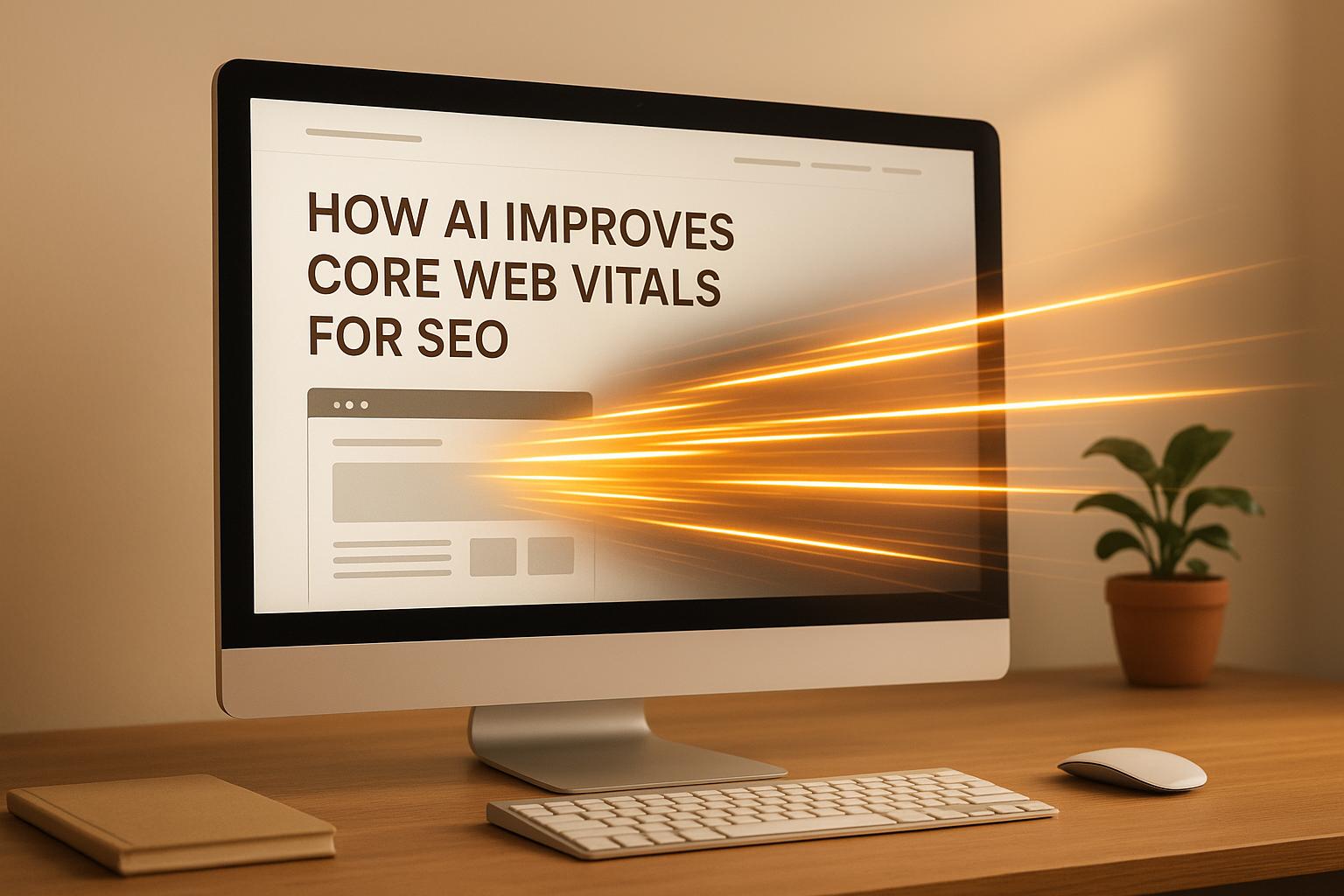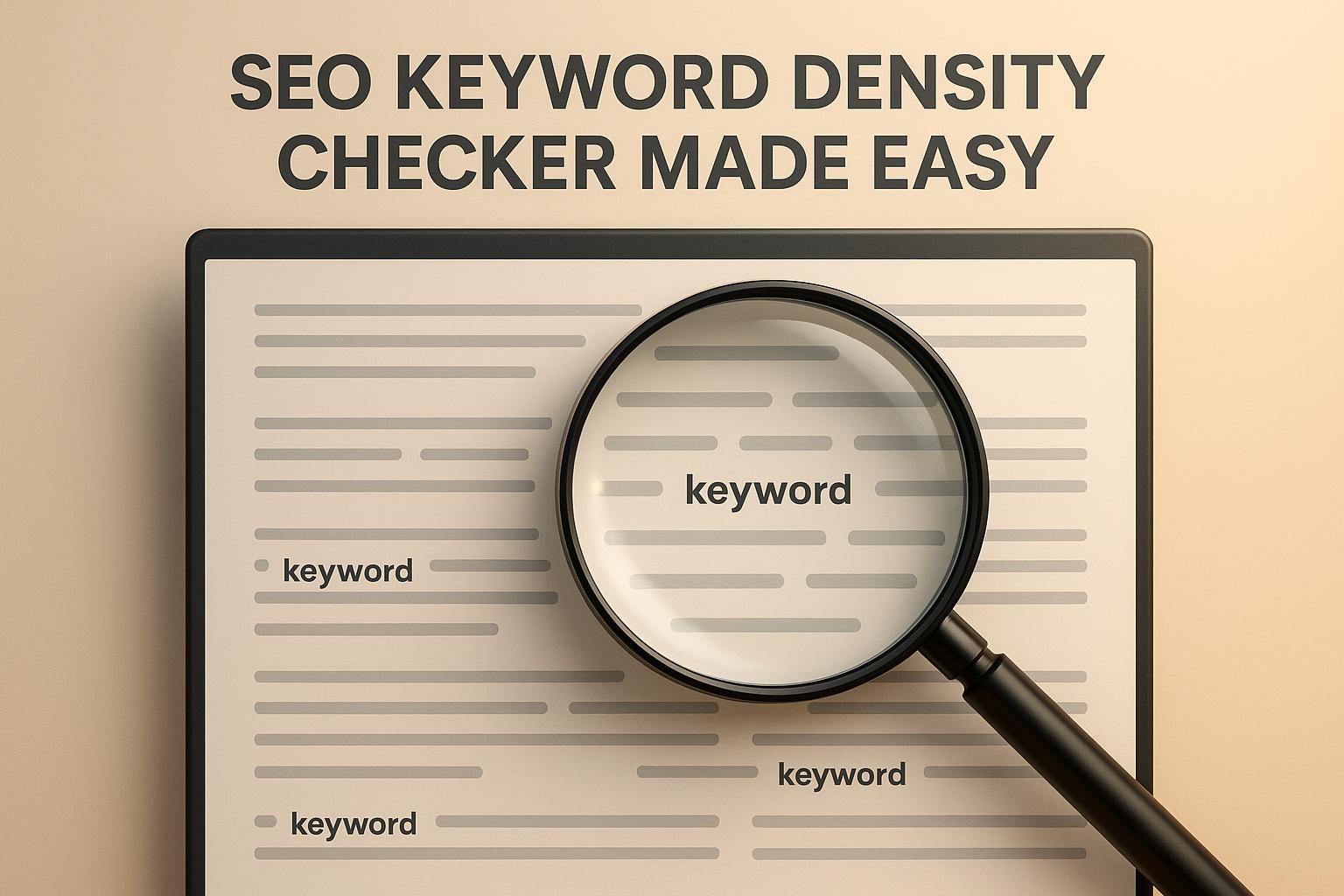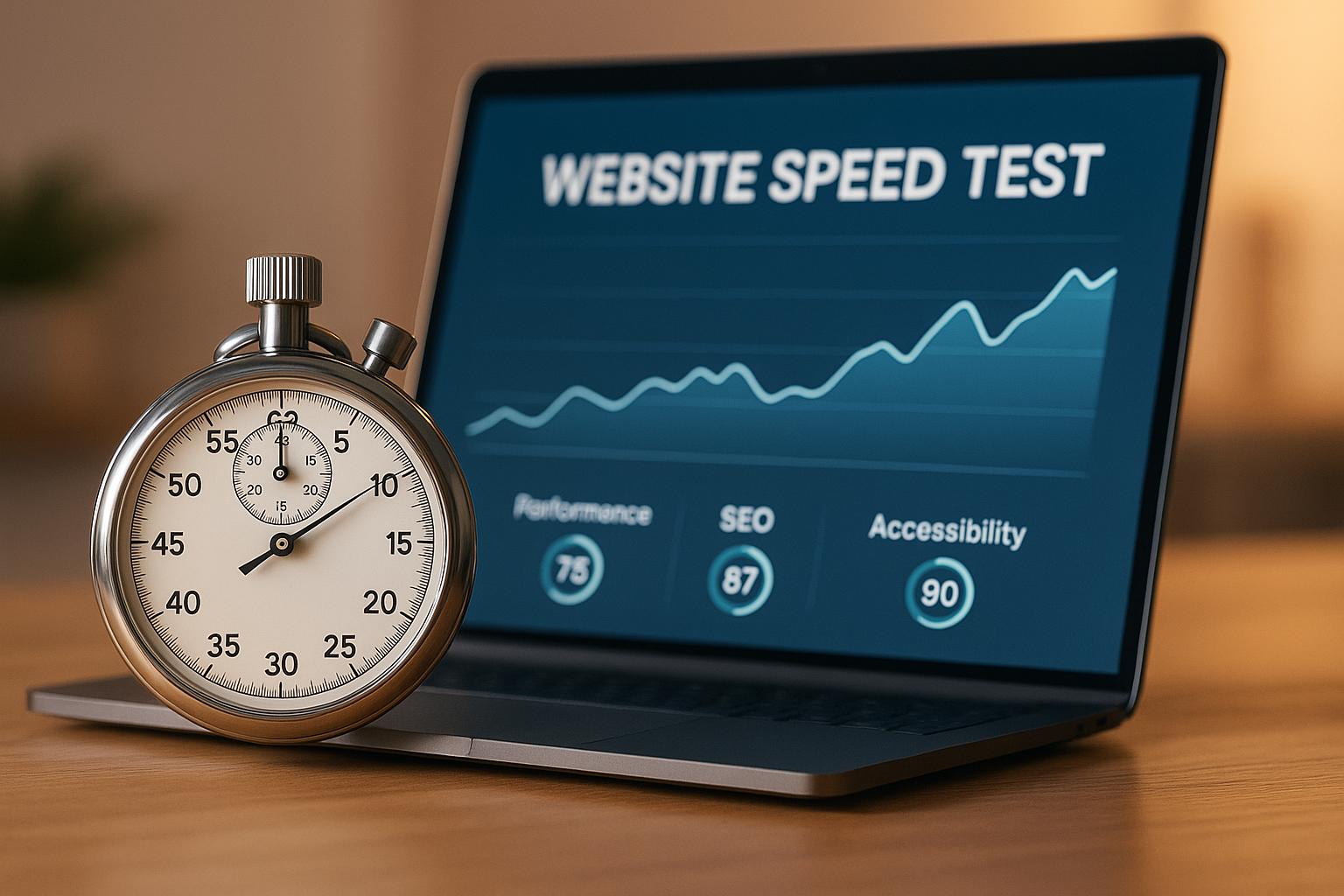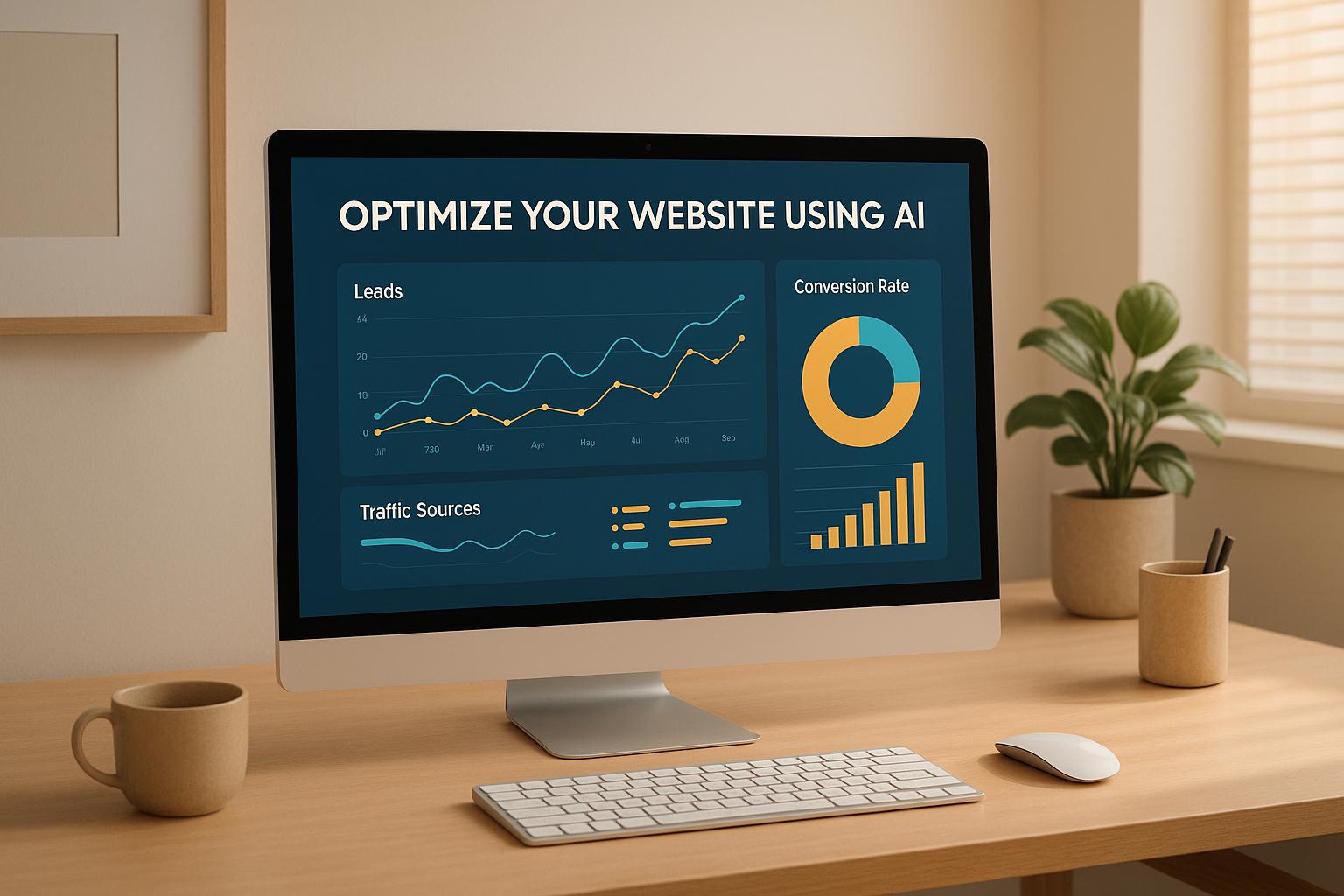

How AI Improves Core Web Vitals for SEO

How AI Improves Core Web Vitals for SEO
 13-10-2025 (Last modified: 13-10-2025)
13-10-2025 (Last modified: 13-10-2025)
Want top search spots and a better site? AI can help. Google’s Core Web Vitals – load time, how it reacts, and how it looks – really shape SEO and keep users. If your site is slow, won’t react, or looks bad, you might lose visitors and drop in search ranks.
Here’s the main point: AI tools now make it easy to boost Core Web Vitals. They spot problems like big images, too much JavaScript, or moving layouts and offer fixes. Quick load times (under 2.5 seconds), quick reactions (under 200ms), and solid looks (CLS under 0.1) can cut exit rates, up conversions, and lift your ranks.
Key Ups of AI for Core Web Vitals:
- Quick Problem Spotting: AI finds slow spots like big images or slow scripts.
- Auto Fixes: AI tools can change image sizes, tweak code, and handle stuff with no hands-on needed.
- Better Site Feel: Smart loading makes moving around smoother and less wait time.
- Watch All The Time: Alerts tell you about slow downs, stopping long-term SEO harm.
In short: AI makes lifting Core Web Vitals simpler, even for those not into tech. Tools like PageTest.AI offer easy ways to test, tweak, and keep your site running well, making sure for fast loads, smooth moves, and better search spots.
Core Web Vitals Optimization… Now Powered by AI! #SiteSpeedWTF #corewebvitals #AI
What Are Core Web Vitals and Why They Matter for SEO
Core Web Vitals are how Google checks how good your website works for real people. See it as a score that can change how high you show up in search results. Google looks at three key things to see if your site is quick, reacts well, and is easy to use, which might help it rank higher – or lower if others do it better.
Look at this: Only 47% of websites pass the Core Web Vitals test. That means more than half might be missing chances to climb higher in search ranks. Google lifts sites with “Good” scores on all three parts, helping them move up in search rankings.
These scores come from real data from the Chrome User Experience Report (CrUX). It’s not just a guess or a test – it’s real info from people going to your site on their gadgets.
“CrUX (Chrome User Experience Report) is the data Google actually uses for rankings, so it’s what really matters.” – Magnet
The gains in rank don’t come at once, but they matter. Sites with top Core Web Vitals scores have seen their ranks go up by 5–10 spots for big-key words. These rises take time, as Google sees and likes the better way users feel as they use the site.
Now, let’s take apart each part to see how they change how well your site does and its SEO.
Largest Contentful Paint (LCP)
LCP cares a lot about first looks. It checks how long it takes for the biggest thing you see on your page – like a big picture, video, or bit of text – to be fully there. For a “Good” score, Google wants this done in 2.5 seconds.
Big LCP troubles come from too-big pictures, slow server answers, and things that block the page. Picture a huge hero image taking 8 seconds to show – it bugs people and sends bad signs to Google. The same goes for videos that start slow or ads that hold back the main stuff, making more people leave and drop ranks.
Interaction to Next Paint (INP, was FID)
INP looks at how quick your site answers during a visit. It notes the time from when a user clicks a thing or taps a link to when they see a result. Google switched from FID to INP to better track quick acts all through the visit.
INP problems often come from too much JavaScript, slow events, or a busy main line. Say a user hits “Add to Cart” and nothing shows for 3 seconds – that’s a bad INP mark. Slow menus or forms that don’t answer can annoy users.
Google’s goal for INP is under 200 milliseconds. Even 100 milliseconds of waiting can drop the chance of a sale by 7%. Quick responses keep users happy and make them more likely to buy.
Cumulative Layout Shift (CLS)
CLS aims to stop sudden changes in content. It tracks how much your page setup moves as it loads. You might have seen this – you’re ready to click a button, but an ad pops up and moves everything, making you click the wrong item. Google marks sites down for these annoying moments.
Usual CLS causes are pictures that load with no set size, ads that show up out of nowhere, or fonts that change after the page is up. For instance, a news piece where text shifts as pictures load makes for bad reading. On shopping sites, sudden changes can mix up buyers and cost sales.
Google wants a CLS score under 0.1. This part is key for phone users, where shifts can bug more. Since phone scores are big in Google’s rank rules, fixing CLS issues can really help your search spot.
Bad CLS not only drops your rank but also stops user fun. People are less likely to stay if they can’t use your site well. Fixing these shifts helps your SEO and keeps users, making their whole visit better and your site work well.
How AI Boosts Core Web Vitals Scores
AI tools are making it easier to find out why a website is slow. You don’t have to spend hours checking code or trying different elements by hand. AI quickly checks images, code, server replies, and loading ways to spot problems that hurt Core Web Vitals. These fast finds save time and help get better SEO ranks by fixing issues well.
AI Finds Problems On Its Own
AI-run tools are built to spot and fix slow spots on your site.
Take image setup, for example. AI looks over your site’s images to find ones that are too big or not set right. It might say to make them smaller, use newer formats like WebP, or start lazy-loading to help your Largest Contentful Paint (LCP) score.
With JavaScript, AI sees scripts that make pages load slow or stop user clicks. It flags scripts that aren’t used or get in the way and gives tips, like delaying or removing them, to help Interaction to Next Paint (INP), which can lift your search ranks.
AI is also good at finding layout shift issues. By watching how parts move while loading, it spots causes like images without set sizes, annoying ads, or fonts that load late – all things that lead to a high Cumulative Layout Shift (CLS). Fixing these not only helps SEO but also makes for a smoother visit.
The main gain here is speed and depth. While manual checks for big websites can take days, AI can give a deep look fast, offering tips to make your load strategies better.
Smarter Loading Based on What Users Do
AI doesn’t just find problems – it also tunes how your site loads content by looking at what users do.
For example, predictive preloading guesses where people will likely go next. If many go from your homepage to a certain product page, AI can load that page in the back, cutting down load times when they click.
It also loads what you can see and need first, which helps LCP more. During busy times, AI can manage resources better, making sure your Core Web Vitals scores stay good even with lots of users.
Constant Checks and Quick Fixes
AI doesn’t just fix things once – it keeps your site running well over time with ongoing checks.
Many AI tools keep tabs on how your site is doing with real-user data, telling you about any changes in your Core Web Vitals. If performance drops because of new plugins, content changes, or more traffic, real-time alerts tell you fast. Some systems go further by tuning things on their own. For instance, if it finds slow images, the system might make them smaller or suggest a new format. If troublesome JavaScript is spotted, it could say to delay those scripts.
Alerts for when your site gets slow help you act fast. They compare your new numbers to old ones. This lets you fix small issues before they grow and hurt how well your site ranks in searches.
Also, AI can give tips for better ways to save pages. It looks at which pages people go to most and guides you on how to store and send them out better. This makes your site load faster all around.
sbb-itb-6e49fcd
Easy Steps to Use AI for Main Web Scores
Using AI to lift your main web scores doesn’t need much tech know-how. By tracking your now score, making better changes, and watching the results, you can slowly do better.
Check Your Now Main Web Scores
First, see where you stand. Use Google PageSpeed Insights to get a free look at your site’s Largest Contentful Paint (LCP), Interaction to Next Paint (INP), and Cumulative Layout Shift (CLS) scores. Just put in your URL, and you’ll get a deep look.
For more deep looks, go to Google Search Console. In the “Experience” part, there’s a “Main Web Scores” report that has real-user details from your site’s visitors. This tells which pages need work and marks clear issues for each score.
Keep in mind, PageSpeed Insights checks lab data (set tests), while Search Console looks at field data (real-world user acts). Both tools give you a full view of how your website does.
Google makes it easy to know your scores: green is good, yellow shows where to get better, and red warns of bad areas. Once you know your spot, you can use AI tools to fix the weak spots.
Use AI to Make Content and Layout Better
After you know your site’s weak spots, tools like PageTest.AI can help you fine-tune your content and layout. This lets you test and change website pieces – like titles, button text, and page designs – no need to know coding.
If your LCP score is low from big hero images, you can try smaller images, other formats, or even text hero sections. PageTest.AI tracks how these tweaks change load times and user clicks, giving you real tips on what does best.
Layout shifts, that mess with your CLS score, often come when parts miss set sizes. By using A/B tests, you can try different button sizes, image spots, or content block designs to find stable layouts while loading. This is good for shops where moving product images or price details can make the user mad.
The best part? These tools need no code, so your marketing team can run tests without waiting for a developer. You can try new titles, action buttons, or product details while watching how they affect Main Web Scores.
Once tweaks are set, it’s key to watch the results.
Watch Results and Keep Getting Better
Getting your Main Web Scores up isn’t a one-time thing. As Google changes its ways and your site grows, regular checks are key. Try to look at your scores at least once a week.
Keep a log of your LCP, INP, and CLS scores with dates. This helps you see patterns and link changes to set updates. For example, if you put in a new add-on on March 15 and saw your CLS score go from 0.05 to 0.15 the next week, you’ve likely found the problem.
Tools such as Google Analytics 4 track how well sites do across devices, places, and user actions. This info helps you see how different things change your site’s numbers.
If your site starts to do poorly, act fast. A short rise in CLS might fix itself, but if the problem stays for days, it may point to a big issue. Fix these issues quick to cut down their bad effects on how users see your site and its place in search results.
To be on top, think about setting up automated alerts. Many tools can tell you if your Core Web Vitals scores go too low, helping you fix things before they turn into larger issues.
How to Check If Your Main Web Stats Are Good
To find out if your website is doing well, you need to look at and check your Core Web Vitals. This tells you how your website works and how that can impact your business. By having the right tools in place, you can see how well your work to make your website better is doing, and make choices based on data.
Watch Changes in Core Web Vitals Scores
It’s key to keep an eye on your Core Web Vitals scores to find issues before they mess up your search rankings. Checking daily can keep you on top of any troubles.
Use tools like Google Search Console and PageSpeed Insights to make tracking easy. Keep tabs on key stats – Largest Contentful Paint (LCP), Interaction to Next Paint (INP), and Cumulative Layout Shift (CLS) – and check them for both mobile and desktop. This way, you can spot issues with specific devices better.
Set up alerts for when scores drop too low. For example, if your LCP is over 2.5 seconds or your CLS is over 0.1, you need to act fast. Tracking these metrics by page type, not just the whole site average, might show you problems you didn’t see before. Like, your home page might be fine, but your product pages could be having problems.
After a few months, like three to six, read back through the data to see trends from things like seasonal traffic, site updates, or changes in content. This helps you see problems coming and think of ways to fix them early.
When you know your Core Web Vitals well, link them to how your business is doing.
Connect Better Core Web Vitals to Better Business Results
Better Core Web Vitals often mean better business. For instance, a faster LCP could mean less people leave your site quickly, and they stick around longer. Better INP could make clicking buttons and filling out forms smoother, which might make more people buy from you. Checking these stats by device helps because people using phones might leave if it’s slow.
Good Core Web Vitals might also help you show up higher in search results. Tools like Google Analytics 4 let you see if more people visit your site as it gets faster. Many sites climb the ranks after fixing big Core Web Vitals problems.
When all three metrics – LCP, INP, and CLS – get better, the site feels a lot smoother. This could mean making more money per visitor, as fast load times, quick clicks, and stable pages make people stay longer and buy more. To see how much better your site is doing, you might use AI tools like PageTest.AI to run tests and see how changes help you sell more.
With this info, you can plan to keep your website good for a long time.
Aim for Long-Term Good Performance
Regular checks help keep and lift your Core Web Vitals as time goes by. Having a monthly check-up, maybe together with your SEO report, helps you stick to your goals and watch how your search ranks change.
Set a top limit for each key number – like aiming for a LCP under 2.5 seconds, an INP under 200 milliseconds, and a CLS below 0.1. If new stuff or features make you go over these limits, you know you need to make it better.
Check your Core Web Vitals when lots of people are on your site to see how it does when it’s very busy. Before you bring in big changes – like new features, a new look, or CMS updates – do tests to see if these changes will make things worse. This can stop bad updates from hitting your live site.
End with a focus on doing well from the start. By using Core Web Vitals needs early on, you stop problems before they start. Look at how other sites like yours do to set real goals and sort out what to fix first and best.
Conclusion: AI Makes Web Vitals Simple
AI changes how we handle Core Web Vitals, making what was once hard and tech-heavy into a smooth, easy job. By seeing, giving tips, and putting in fixes right away, AI lifts the big load from your back.
Instead of constant hands-on checks and tweaks, AI tools work quietly, always bettering your site’s speed. These systems learn from what users do, aiming to load faster, send out content better, and stop layout jumps before they mess up someone’s view. The end? Your Largest Contentful Paint (LCP) keeps below 2.5 seconds, your Interaction to Next Paint (INP) is under 200 milliseconds, and your Cumulative Layout Shift (CLS) remains below 0.1 – all without your constant eye.
For businesses with no tech teams, AI tools make things easy. Places like PageTest.AI give no-code ways that let you try out different content, watch how shifts touch speed scores, and fix parts that change Core Web Vitals and sales rates. These tools even make content forms that mix good looks with quick loading.
AI does not just fix what’s now – it sees ahead. By looking at traffic flows and content changes, AI tools work ahead to keep away likely troubles, making sure your Core Web Vitals stay strong as your site grows.
Better yet, AI gives clear views on how these changes help your work. Quicker loading cuts down on people leaving, smoother moves lift sales, and steady layouts up interest. This clear tie between speed scores and work wins means you’re not just hitting Core Web Vitals marks – you’re making real growth.
With AI doing the tech work, you’re free to put your mind on what matters: making great content and growing your work, all while knowing your site is set right for both search spots and your viewers.
FAQs
Related Blog Posts
say hello to easy Content Testing
try PageTest.AI tool for free
Start making the most of your websites traffic and optimize your content and CTAs.
Related Posts

 04-12-2025
04-12-2025
 Ian Naylor
Ian Naylor
SEO Keyword Density Checker Made Easy
Analyze keyword frequency with our free SEO Keyword Density Checker. Ensure your content is optimized and avoid overstuffing penalties!

 02-12-2025
02-12-2025
 Ian Naylor
Ian Naylor
Website Speed Test for Instant Insights
Test your website speed with our free tool! Enter a URL to get instant insights on load time, TTFB, and more. Optimize your site today!

 01-12-2025
01-12-2025
 Ian Naylor
Ian Naylor
How to Optimize Your Website for More Leads Using AI
Learn how to optimize your website for more leads using AI. Discover actionable tips for better conversions and trust-building strategies.
